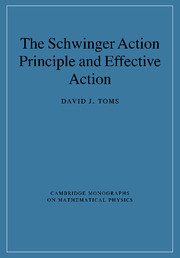Book contents
- Frontmatter
- Contents
- Preface
- 1 Action principle in classical mechanics
- 2 Action principle in classical field theory
- 3 Action principle in quantum theory
- 4 The effective action
- 5 Quantum statistical mechanics
- 6 Effective action at finite temperature
- 7 Further applications of the Schwinger action principle
- 8 General definition of the effective action
- Appendix 1 Mathematical appendices
- Appendix 2 Review of special relativity
- Appendix 3 Interaction picture
- Bibliography
- Index
8 - General definition of the effective action
Published online by Cambridge University Press: 27 October 2009
- Frontmatter
- Contents
- Preface
- 1 Action principle in classical mechanics
- 2 Action principle in classical field theory
- 3 Action principle in quantum theory
- 4 The effective action
- 5 Quantum statistical mechanics
- 6 Effective action at finite temperature
- 7 Further applications of the Schwinger action principle
- 8 General definition of the effective action
- Appendix 1 Mathematical appendices
- Appendix 2 Review of special relativity
- Appendix 3 Interaction picture
- Bibliography
- Index
Summary
This chapter presents the application of the Schwinger action principle to interacting field theory. We concentrate on the case of scalar fields for simplicity. It will be shown how the perturbative expansion of the effective action can be obtained in a systematic manner. The renormalization of interacting scalar fields with a quartic self-interaction is discussed using this formalism to two-loop order. We will see how to incorporate finite temperature effects into the formalism and then discuss Bose–Einstein condensation using a generalization of the effective action due to Callan, Jackiw, and Tomboulis (Cornwall et al., 1974).
Generating functionals for free field theory
The action integral for a typical theory that we are interested in is local in the sense that it only involves the integral of fields at the same spacetime point. (See the examples of Chapter 2.) When we replace the classical fields with operators, this means that the time-ordering operation is not important in the action. This is also true for the equations of motion. In this section we will follow essentially the same procedure as we did in Section 7.7, but this time for field theory.
Suppose that we consider a free field theory with a field operator denoted by φI (t, x). Here I runs over any type of indices that the field might have. We will initially assume that φI(t, x) is a Bose field to avoid the complication of dealing with anti-commuting numbers.
- Type
- Chapter
- Information
- The Schwinger Action Principle and Effective Action , pp. 368 - 446Publisher: Cambridge University PressPrint publication year: 2007



